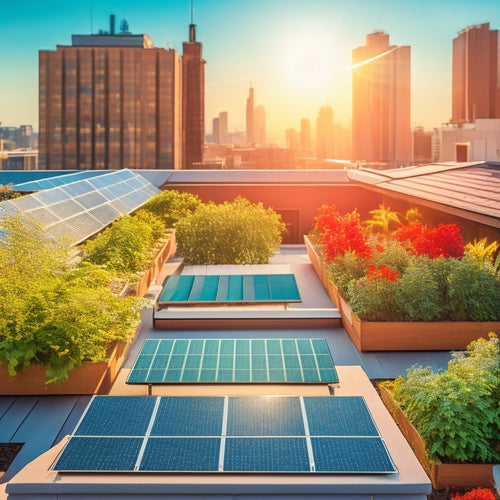
7 Essential Steps for Efficient Solar System Design
Share
You're designing a solar system and want to get it right. Start by evaluating your energy demands and goals through an energy audit and analysis. Next, select the best solar panel type based on efficiency, technology, and cost. Configure your system's size and layout, considering energy needs and potential losses. Then, evaluate your roof and site conditions, factoring in structural integrity and aesthetics. Choose high-efficiency inverters and a suitable mounting system, ensuring electrical safety and compliance. Finally, perform shading and energy analysis to optimize your system's design. Now, discover how to execute each step for a truly efficient solar system design.
Key Takeaways
• Conduct a thorough energy audit to identify areas of inefficiency and determine peak shaving opportunities in the solar system design.
• Select high-efficiency solar panels considering factors such as panel efficiency, cell technology, and cost to ensure optimal energy production.
• Optimize system sizing and design by calculating daily energy needs, considering system losses, and minimizing shading effects.
• Ensure electrical safety and compliance by verifying code compliance, preventing electrical shock and fires, and guaranteeing safe system operation.
• Perform shading and energy analysis to assess environmental factors, determine optimal panel placement, and optimize system design for maximum energy output.
Assessing Energy Demands and Goals
To accurately design a solar system, you must first determine your energy demands and goals, as this information will serve as the foundation for all subsequent design decisions. This involves conducting a thorough energy audit to identify areas of inefficiency and opportunities for improvement.
Load profiling is an essential step in this process, as it helps you understand your energy usage patterns and identify peak periods of consumption. By analyzing your energy usage data, you can identify opportunities for peak shaving, reducing your energy consumption during periods of high demand.
Energy auditing involves a detailed assessment of your energy usage, including lighting, HVAC, and plug loads. This information will help you determine the size and type of solar system required to meet your energy needs.
Selecting Optimal Solar Panel Types
With your energy demands and goals defined, you're now ready to select the most suitable solar panel type that meets your specific requirements. This decision is important, as it directly impacts your system's overall performance and efficiency.
When choosing a solar panel type, you'll need to take into account factors such as panel efficiency, cell technology, and durability.
Panel efficiency, measured in percentage, indicates how effectively a panel converts sunlight into electricity. Higher efficiency panels are ideal for smaller rooftops or areas with limited space. However, they often come at a higher cost. Monocrystalline silicon cells, for instance, offer high efficiency rates but are more expensive than polycrystalline silicon cells.
Your selection should also take into consideration the cell technology used in the panel. Monocrystalline silicon cells are more efficient than polycrystalline silicon cells, but the latter is more affordable. Thin-film solar cells, on the other hand, are less efficient but offer a more budget-friendly option.
Configuring System Sizing and Layout
You've selected the best solar panel type, and now it's time to configure your system's sizing and layout to guarantee maximum energy harvesting. This pivotal step ensures your system operates at peak efficiency. To achieve peak performance, you'll need to determine the ideal system size and layout strategy.
Here are key considerations for system optimization:
-
Assess your energy requirements: Calculate your daily energy needs to determine the required system size.
-
Evaluate system losses: Consider losses due to temperature, wiring, and other factors to ensure accurate system sizing.
-
Choose an efficient layout strategy: Select a layout that minimizes shading, reduces wiring distances, and optimizes panel orientation.
- Simulate system performance: Use software tools to simulate your system's performance under various conditions, ensuring maximum energy harvesting.
Evaluating Roof and Site Conditions
When evaluating roof and site conditions, you'll need to assess the roof's size and shape to determine the available space for your solar array.
You'll also need to analyze potential shading obstructions, such as trees or neighboring buildings, to guarantee maximum energy production.
Additionally, you must perform a structural integrity check to verify that the roof can support the weight of the solar panels.
Roof Size and Shape
Determine the roof's dimensions and orientation to guarantee ideal solar panel placement and energy harvesting, taking into consideration obstructing features like vents, skylights, and chimneys. This evaluation is essential to secure maximum energy production and to avoid any potential issues during installation.
When evaluating your roof's size and shape, consider the following factors:
-
Roof aesthetics: Will the solar panels complement or detract from the roof's appearance?
-
Architectural constraints: Are there any structural limitations that may impact solar panel placement or installation?
-
Obstruction clearance: Are there any obstructions, such as vents or skylights, that may affect solar panel placement?
- Orientation and tilt: What's the most effective orientation and tilt for your solar panels to maximize energy production?
Shading Obstructions Analysis
Now that you've assessed your roof's size and shape, it's time to identify potential shading obstructions that could impact your solar panel system's performance.
Shading obstructions can greatly reduce the energy output of your solar panels, so it's important to evaluate your roof and site conditions carefully.
Start by examining the tree canopy impact on your roof. If you have trees nearby, their branches and leaves can cast shadows on your solar panels, reducing their efficiency. Take note of the tree species, their proximity to your roof, and the time of year when they're most likely to cast shadows. Consider trimming or pruning trees to minimize their impact.
Next, assess the neighboring building shadow. If you live in a densely populated area, nearby buildings can cast shadows on your roof, especially during peak sun hours. Take into account the height and proximity of nearby buildings to determine their potential impact on your solar panel system.
Structural Integrity Check
As you prepare to install your solar panel system, you must assess your roof's structural integrity to guarantee it can securely support the added weight and withstand various environmental conditions. This involves evaluating the roof's material strength, load calculations, and potential vulnerabilities.
To safeguard a secure installation, consider the following factors:
-
Roof material and condition: Assess the type, age, and condition of your roof to determine its ability to support the added weight of the solar panels.
-
Load calculations: Perform calculations to determine the maximum weight your roof can handle, taking into account environmental factors like wind, snow, and seismic activity.
-
Structural reinforcements: Identify potential weaknesses in your roof's structure and consider reinforcements, such as additional beams or supports, to guarantee the roof can withstand the added weight.
- Site-specific conditions: Evaluate your site's unique conditions, including wind direction, snowfall, and soil stability, to certify your solar panel system is designed to withstand local environmental stresses.
Choosing Inverters and Mounting Systems
When sizing your solar array, you'll need to select an inverter that efficiently converts DC power into AC, ensuring a seamless interface with the grid and maximum energy harvest. A vital inverter is important, as it directly impacts the system's overall performance and lifespan. Look for inverters with high efficiency ratings, low maintenance requirements, and robust monitoring capabilities.
Inverter reliability is key, as it directly affects the system's uptime and energy production.
In addition to inverter selection, you'll need to choose a suitable mounting system that guarantees flexibility and adaptability. Mounting flexibility is crucial, as it allows for adjustments to be made during installation and future system upgrades.
A versatile mounting system should accommodate various roof types, angles, and orientations. It's crucial to take into account the structural integrity of the mounting system, ensuring it can withstand environmental stresses and support the weight of the solar panels.
Ensuring Electrical and Safety Codes
You must verify that your solar system design complies with relevant electrical and safety codes to prevent electrical shock, fires, and other hazards, guaranteeing a safe and reliable system operation. Code compliance is critical to avoid electrical hazards that can lead to injuries, fatalities, or property damage. As a designer, it's crucial to familiarize yourself with local and national electrical codes, such as the National Electric Code (NEC) in the United States.
To confirm compliance, consider the following:
-
Verify that your system meets the requirements for grounding and bonding, including proper connections and sizing of equipment grounding conductors.
-
Ensure that your system's electrical components, including inverters, combiner boxes, and disconnects, meet the required certifications and listings.
-
Design your system to prevent electrical shock, arc faults, and other hazards, using techniques such as grounding fault protection and arc fault detection.
- Conduct regular inspections and testing to identify potential electrical hazards and guarantee that your system operates safely and efficiently.
Performing Shading and Energy Analysis
With electrical and safety codes guaranteed, you can now focus on optimizing your solar system's energy output by performing a thorough shading and energy analysis. This step is crucial in determining the system's performance and identifying potential energy losses.
You'll need to assess the site's environmental factors, including the Tree Canopy's impact on solar irradiance. Consider the Building Orientation and its effect on energy production. A detailed analysis will help you identify the best panel placement and tilt to maximize energy output.
Using specialized software or consulting with a solar expert, you'll need to create a 3D model of the site, incorporating the building's architecture and surroundings. This will enable you to simulate the shading patterns and energy production throughout the day and year.
The analysis will reveal the system's energy output during different periods, helping you optimize the design and minimize energy losses. By accounting for these factors, you can guarantee your solar system operates at peak efficiency, providing the maximum return on investment.
Frequently Asked Questions
Can Solar Panels Be Installed on a Metal Roof?
You can install solar panels on a metal roof using metal mounting systems, which provide a secure attachment method, ensuring a watertight seal and efficient roof integration, while minimizing roof penetration and potential leaks.
How Often Should Solar Panels Be Cleaned?
"When the dust settles, literally, on your solar panels, remember to clean them regularly to avoid energy losses; ideally, you'll want to clean them every 6-12 months to maximize energy output and prevent dust accumulation."
Are There Any Solar Panel Recycling Programs?
You'll find that many manufacturers offer take-back programs or partner with recycling facilities, enabling responsible waste reduction strategies and environmental responsibility, as you consider solar panel recycling programs for your used modules.
Can I Install Solar Panels Myself?
As you start on a DIY solar journey, beware of the treacherous terrain of DIY challenges, where one misstep can lead to electrical shocks or roof damage; prioritize safety precautions, and carefully weigh the risks before taking on the installation solo.
Are Solar Panels Resistant to Hail Damage?
When a hail storm hits, you'll want to know if your solar panels can withstand the impact; while they're built to resist damage, it's important to review insurance coverage options to make sure you're protected from potential losses.
Related Posts
-

Solar System Installation Rebates and Tax Credits
Solar system installations offer beneficial rebates and tax credits that greatly cut your initial costs. You can bene...
-

Evaluating Solar Power Options for Businesses
Evaluating solar power options for your business can greatly reduce energy costs and enhance sustainability. Start by...
-

High-Performance Energy-Efficient HVAC Systems
High-performance energy-efficient HVAC systems are essential for reducing energy consumption while improving indoor c...


